Spatiotemporal Decoupling between Population and Construction Land in Urban and Rural Hubei Province
Abstract
:1. Introduction
2. Materials and Methods
2.1. Study Area
2.2. Data Sources
2.3. Method
3. Results
3.1. Changes in Urban–Rural Construction Land
3.2. Changes in Population
3.3. Decoupling States Compared across Time and Space
3.3.1. Spatiotemporal Decoupling between the Total Population and the Construction Land Area
3.3.2. Spatiotemporal Decoupling between the Urban Population and the Urban Construction Land Area
3.3.3. Spatiotemporal Decoupling between the Rural Population and Rural Settlement Land Area
3.3.4. The Coordination Relationship of the Urban–Rural Population and Construction Land Change and Classification
4. Discussion
4.1. Dynamic Allocation of New Construction Land Use Indicators
4.2. From “Increasing vs. Decreasing Balance” to “Population Land Hook”
4.3. Priorities in Further Study
5. Conclusions
Acknowledgments
Author Contributions
Conflicts of Interest
References
- Bai, X.; Shi, P.; Liu, Y. Realizing China’s urban dream. Nature 2014, 509, 158–160. [Google Scholar] [CrossRef] [PubMed]
- Liu, Y.; Wang, L.; Long, H. Spatio-temporal analysis of land-use conversion in the eastern coastal China during 1996–2005. J. Geogr. Sci. 2008, 18, 274–282. [Google Scholar] [CrossRef]
- Deng, X.; Huang, J.; Rozelle, S.; Uchida, E. Growth, population and industrialization, and urban land expansion of China. J. Urban Econ. 2008, 63, 96–115. [Google Scholar] [CrossRef]
- Liu, J.; Zhan, J.; Deng, X. Spatio-temporal Patterns and Driving Forces of Urban Land Expansion in China during the Economic Reform Era. Ambio 2005, 34, 450–455. [Google Scholar] [CrossRef] [PubMed]
- Chan, K.W. Urbanization and Rural-Urban Migration in China since 1982: A New Baseline. Mod. China 1994, 20, 243–281. [Google Scholar] [CrossRef]
- National Bureau of Statistics of China. China Statistical Yearbook; China Statistics Press: Beijing, China, 2015. [Google Scholar]
- Ministry of Housing and Urban-Rural Development, P.R. China. China Urban-Rural Construction Statistical Yearbook; China Statistics Press: Beijing, China, 2014. [Google Scholar]
- Tan, M.; Li, X.; Lu, C.; Luo, W.; Kong, X.; Ma, S. Urban population densities and their policy implications in China. Habitat Int. 2008, 32, 471–484. [Google Scholar] [CrossRef]
- Long, H.; Li, Y.; Liu, Y.; Woods, M.; Zou, J. Accelerated restructuring in rural China fueled by ‘increasing vs. decreasing balance’ land-use policy for dealing with hollowed villages. Land Use Policy 2012, 29, 11–22. [Google Scholar] [CrossRef]
- Zhou, G.; He, Y.; Tang, C.; Yu, T.; Xiao, G.; Zhong, T. Dynamic mechanism and present situation of rural settlement evolution in China. J. Geogr. Sci. 2013, 23, 513–524. [Google Scholar] [CrossRef]
- Liu, Y.; Liu, Y.; Chen, Y.; Long, H. The process and driving forces of rural hollowing in China under rapid urbanization. J. Geogr. Sci. 2010, 20, 876–888. [Google Scholar] [CrossRef]
- Li, Y.; Liu, Y.; Long, H.; Cui, W. Community-based rural residential land consolidation and allocation can help to revitalize hollowed villages in traditional agricultural areas of China: Evidence from Dancheng County, Henan Province. Land Use Policy 2014, 39, 188–198. [Google Scholar] [CrossRef]
- Long, H. Land consolidation: An indispensable way of spatial restructuring in rural China. J. Geogr. Sci. 2014, 24, 211–225. [Google Scholar] [CrossRef]
- Liu, Y.; Fang, F.; Li, Y. Key issues of land use in China and implications for policy making. Land Use Policy 2014, 40, 6–12. [Google Scholar] [CrossRef]
- Long, H.; Liu, Y.; Wu, X.; Dong, G. Spatio-temporal dynamic patterns of farmland and rural settlements in Su-Xi-Chang region: Implications for building a new countryside in coastal China. Land Use Policy 2009, 26, 322–333. [Google Scholar] [CrossRef]
- Xie, Y.; Fang, C.; Lin, G.C.S.; Gong, H.; Qiao, B. Tempo-Spatial Patterns of Land Use Changes and Urban Development in Globalizing China: A Study of Beijing. Sensors 2007, 7, 2881–2906. [Google Scholar] [CrossRef]
- Wang, X.; Hui, E.C.; Choguill, C.; Jia, S. The new urbanization policy in China: Which way forward? Habitat Int. 2015, 47, 279–284. [Google Scholar] [CrossRef]
- Chen, R.; Ye, C.; Cai, Y.; Xing, X.; Chen, Q. The impact of rural out-migration on land use transition in China: Past, present and trend. Land Use Policy 2014, 40, 101–110. [Google Scholar] [CrossRef]
- Shi, M.; Xie, Y.; Cao, Q. Spatiotemporal Changes in Rural Settlement Land and Rural Population in the Middle Basin of the Heihe River, China. Sustainability 2016, 8, 614. [Google Scholar] [CrossRef]
- Yang, H.; Li, X. Cultivated land and food supply in China. Land Use Policy 2000, 17, 73–88. [Google Scholar] [CrossRef]
- Tan, M.; Li, X.; Lu, C. Urban land expansion and arable land loss of the major cities in China in the 1990s. Sci. China Ser. D Earth Sci. 2005, 48, 1492–1500. [Google Scholar] [CrossRef]
- Turner Ii, B.L.; Skole, D.; Sanderson, S.; Fischer, G.; Fresco, L.; Leemans, R. Land-Use and Land-Cover Change-Science/Research Plan; IGBP Report 35/HDP Report 7; International Geosphere-Biosphere Programme: Stockholm, Sweden, 1995. [Google Scholar]
- López, E.; Bocco, G.; Mendoza, M.; Duhau, E. Predicting land-cover and land-use change in the urban fringe: A case in Morelia city, Mexico. Landsc. Urban Plan. 2001, 55, 271–285. [Google Scholar] [CrossRef]
- Li, L.; Sato, Y.; Zhu, H. Simulating spatial urban expansion based on a physical process. Landsc. Urban Plan. 2003, 64, 67–76. [Google Scholar] [CrossRef]
- Xiao, D. Urbanization process and the sustainable utilization of land resources. Yunnan Geogr. Environ. Res. 1997, 9, 34–39. [Google Scholar]
- OECD. Sustainable Development: Indicators to Measure Decoupling of Environmental Pressure from Economic Growth; The Organization for Economic Co-operation and Development (OECD): Paris, France, 2001. [Google Scholar]
- Tapio, P. Towards a theory of decoupling: Degrees of decoupling in the EU and the case of road traffic in Finland between 1970 and 2001. Transp. Policy 2005, 12, 137–151. [Google Scholar] [CrossRef]
- Chen, B.; Du, H. Analyzing decoupling relationship between arable land occupation and GDP growth. Resour. Sci. 2006, 28, 36–42. [Google Scholar]
- Li, X.; Qu, F.; Guo, Z.; Jiang, D.; Pan, Y.; Chen, X. Decoupling between urban and rural construction land. China Popul. Resour. Environ. 2008, 18, 179–184. [Google Scholar]
- Song, W.; Liu, M. Assessment of decoupling between rural settlement area and rural population in China. Land Use Policy 2014, 39, 331–341. [Google Scholar] [CrossRef]
- Wang, J.; Fang, C.; Li, Y. Spatio-temporal analysis of population and construction land change in urban and rural China. J. Nat. Resour. 2014, 29, 1271–1281. [Google Scholar]
- Guo, J.; Bao, Q.; Ou, M. Study on Incremental Construction Land Quotas Allocation in China based on Resource Endowments and Economic Development Regional Differences. China Land Sci. 2016, 30, 71–80. [Google Scholar]
- Lu, Z.; Wu, C.; Yue, W. Study on Dynamic Regional Allocation of Construction Land Quotas in General Land Use Planning. China Land Sci. 2010, 24, 59–65. [Google Scholar]
- Liu, Y.; Luo, T.; Liu, Z.; Kong, X.; Li, J.; Tan, R. A comparative analysis of urban and rural construction land use change and driving forces: Implications for urban-rural coordination development in Wuhan, Central China. Habitat Int. 2015, 47, 113–125. [Google Scholar] [CrossRef]
- Wang, Y.; Liu, Y.; Li, Y.; Li, T. The spatio-temporal patterns of urban–rural development transformation in China since 1990. Habitat Int. 2016, 53, 178–187. [Google Scholar] [CrossRef]
- Li, Y. Urban-rural interaction patterns and dynamic land use: Implications for urban–rural integration in China. Reg. Environ. Chang. 2012, 12, 803–812. [Google Scholar] [CrossRef]
- Long, H.; Zou, J.; Pykett, J.; Li, Y. Analysis of rural transformation development in China since the turn of the new millennium. Appl. Geogr. 2011, 31, 1094–1105. [Google Scholar] [CrossRef]
- Fan, H.; Liu, W.; Shan, N. Study on the exiting strategy of rural residential land in China. Sci. Technol. Manag. Land Resour. 2016, 16–25. [Google Scholar]
- The state council of the People's Republic of China. The Guiding Opinions for Supporting Henan Province to Speed up the Construction of the Central Plains Economic Zone of China by the State Council. Available online: http://www.gov.cn/zwgk/2011-10/07/content_1963574.htm (assessed on 9 May 2017).
- National Development and Reform Commission. Planning for a Central Plains Economic Zone (2012–2020). Available online: http://www.hunan.gov.cn/2015xxgk/szfzcbm/tjbm/ghjh/201605/t20160517_3058426.html (assessed on 9 May 2017).
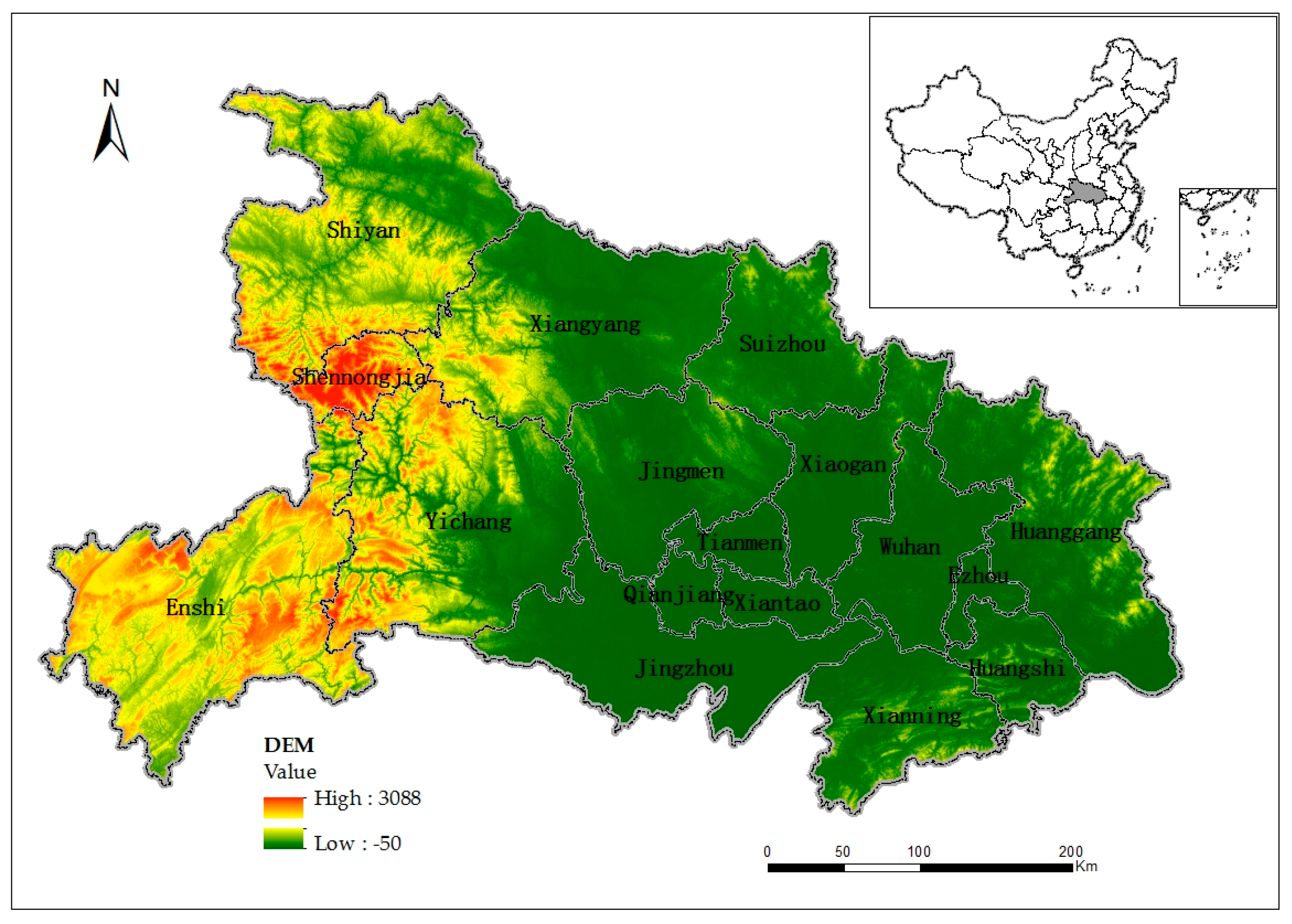
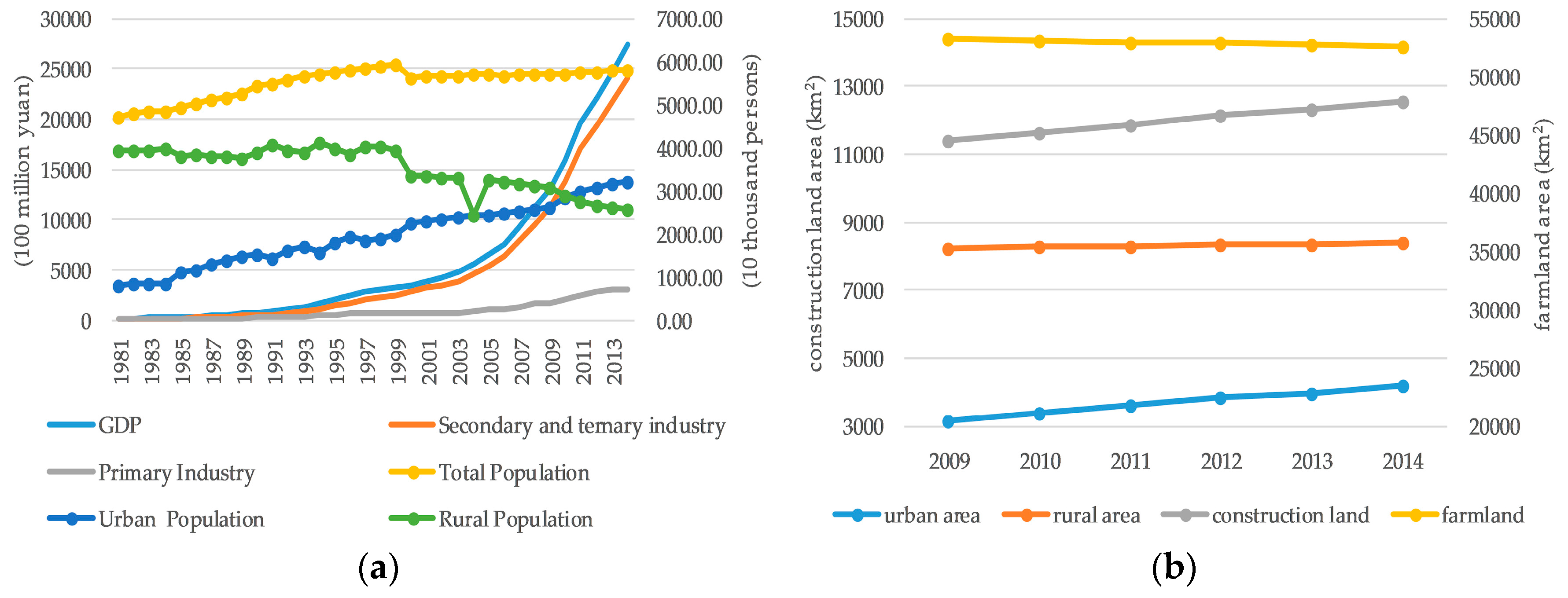

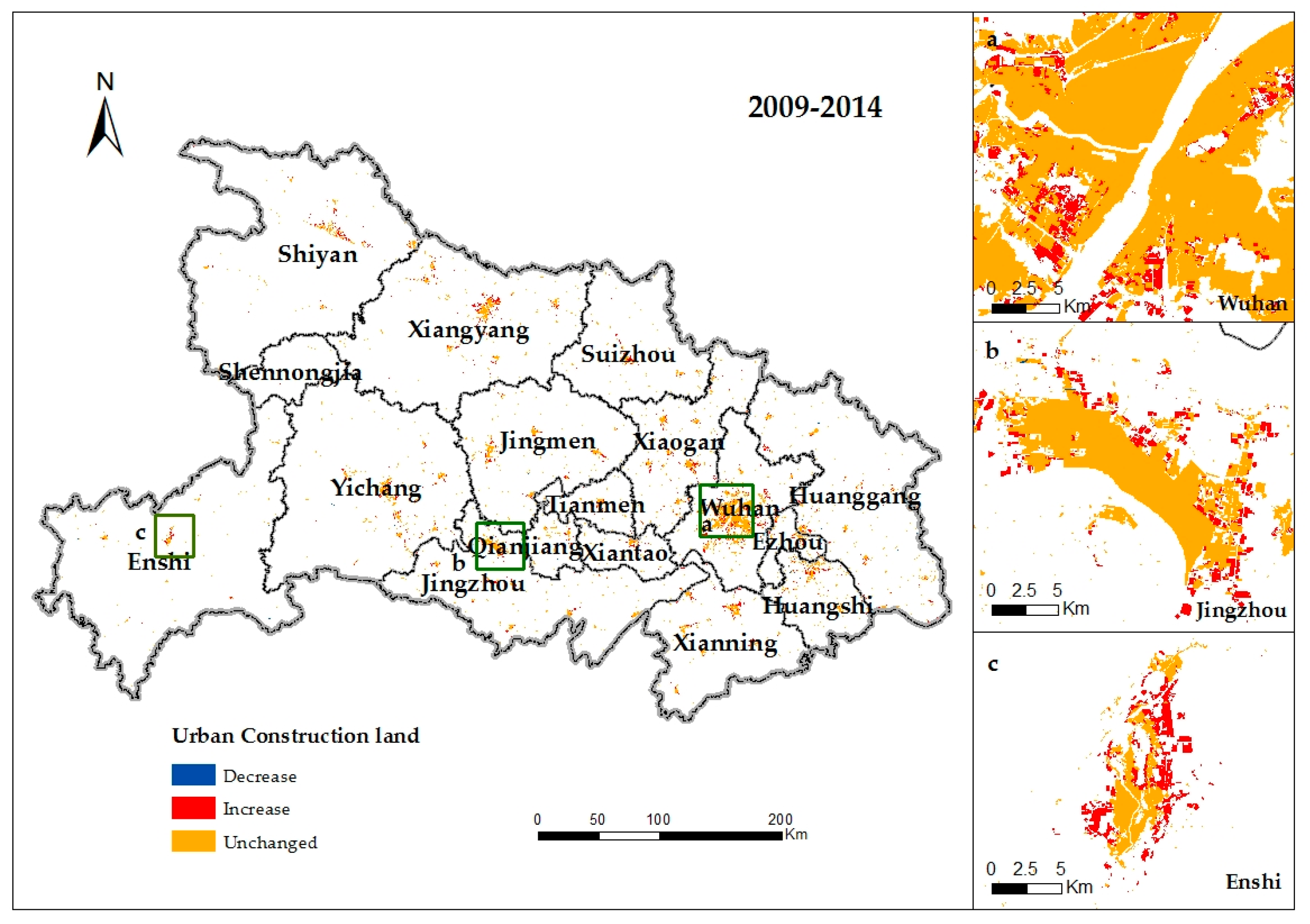
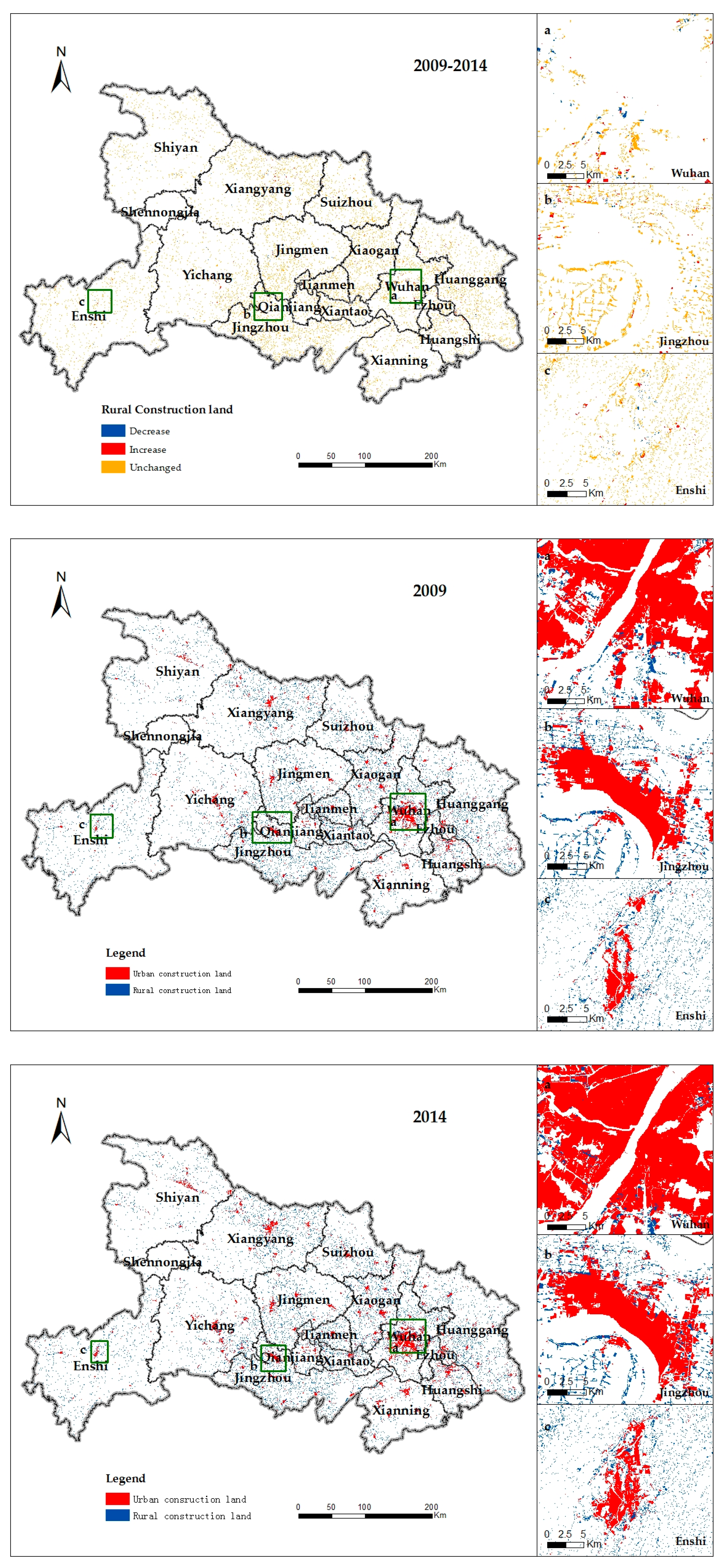
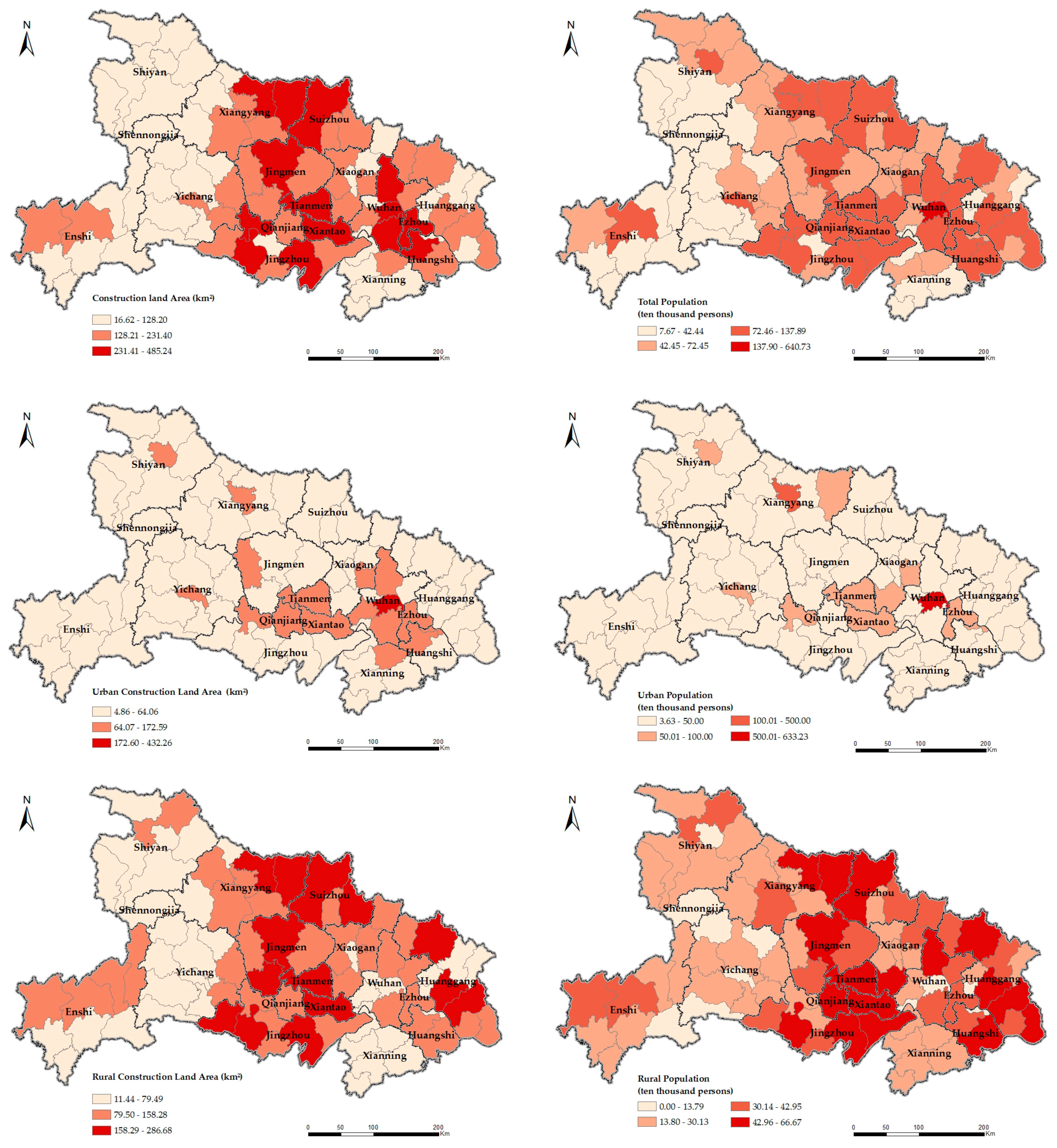
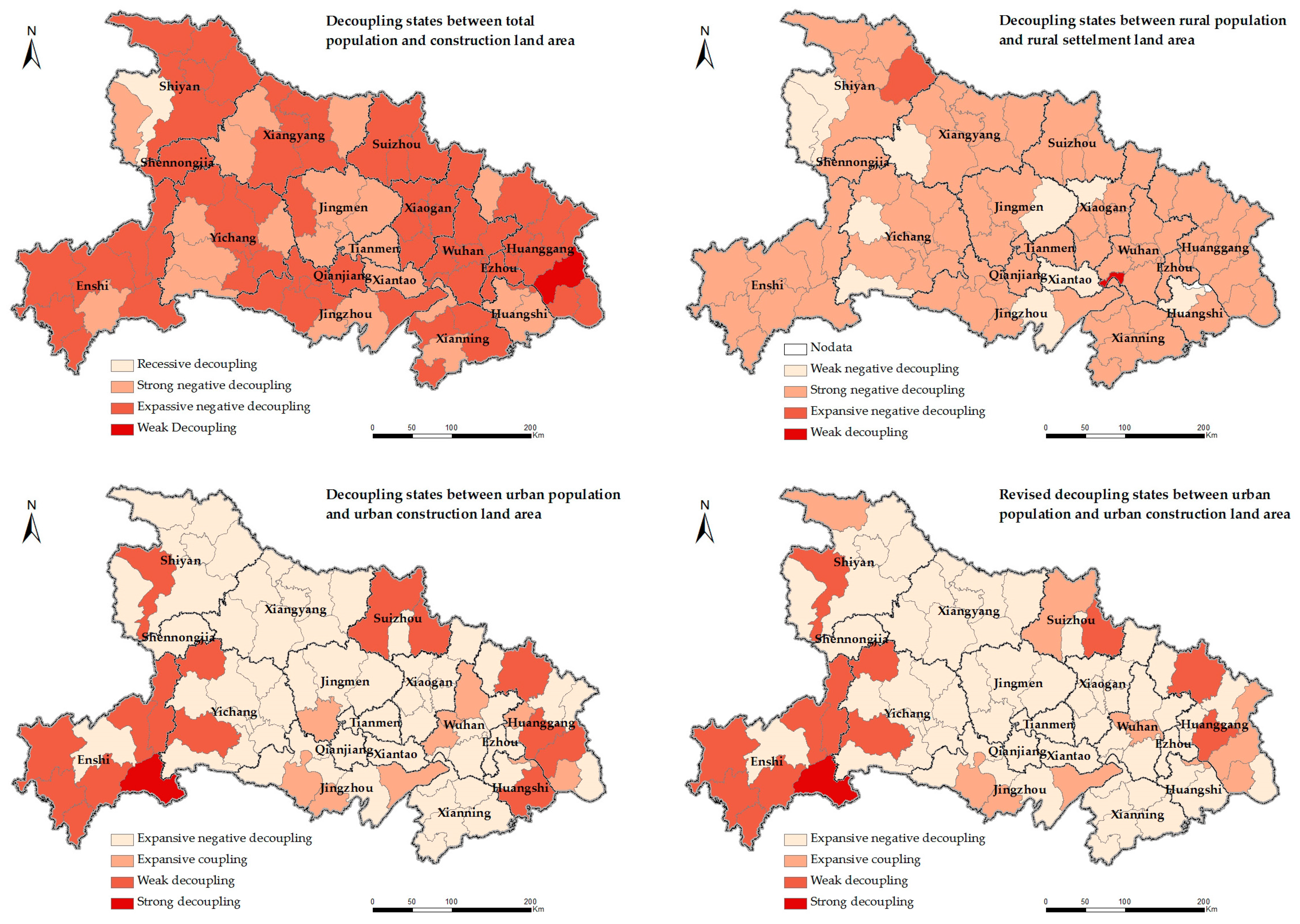

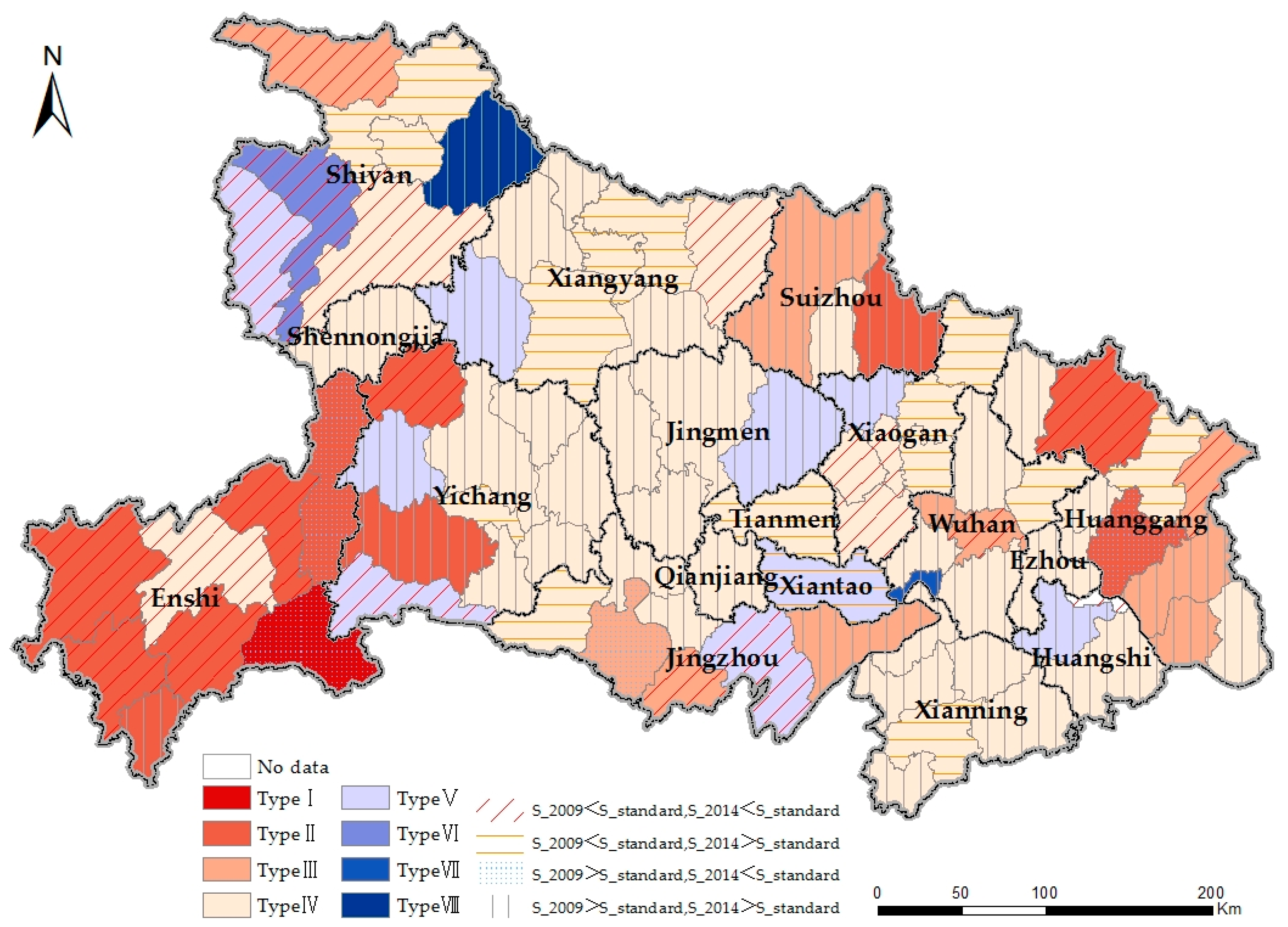
| Land Use Type | 2009 | 2014 | 2009–2014 | |||
|---|---|---|---|---|---|---|
| Area | %Total | Area | %Total | Variation | %Rate | |
| Urban construction land | 3225.18 | 1.73 | 4240.27 | 2.28 | 1015.09 | 31.47 |
| City | 1419.32 | 0.76 | 1813.35 | 0.98 | 394.03 | 27.76 |
| Town | 1351.36 | 0.73 | 1965.51 | 1.06 | 614.15 | 45.45 |
| Industry/mining land | 454.50 | 0.24 | 461.41 | 0.25 | 6.91 | 1.52 |
| Rural construction land | 8463.48 | 4.55 | 8623.02 | 4.64 | 159.54 | 1.89 |
| 2009 | 2014 | Variation | %Rate | %Average Annual Rate of Change | |
|---|---|---|---|---|---|
| Urban population | 2844.51 | 3238.47 | 393.96 | 13.85 | 2.63 |
| Rural population | 2879.26 | 2577.52 | −301.74 | −10.48 | −2.19 |
| Total population | 5723.77 | 5815.99 | 92.23 | 1.61 | 0.32 |
| Type | Urban Construction Land Per Capita | Number | Suggestion | ||
|---|---|---|---|---|---|
| I | > | 1 | Relax the approval of urban construction land | Strictly control the expansion of rural settlement land, prevent the loss of rural population and strengthen the rural settlements land consolidation | |
| II | II | 6 | Relax the approval of urban construction land appropriately | ||
| II-2 | 2 | ||||
| II-3 | 3 | Appropriately control the urban expansion and actively revitalize the stock of construction land | |||
| III | III-1 | 4 | Relax the approval of urban construction land appropriately | ||
| III-2 | 5 | Control the urban expansion | |||
| III-3 | 1 | Relax the approval of urban construction land appropriately | |||
| IV | IV-1 | 6 | Maintain the relationship between urban expansion and population growth | ||
| IV-2 | 14 | Strictly control urban expansion and actively revitalize the stock of construction land | |||
| IV-3 | 30 | ||||
| V | V-1 | 3 | Maintain the relationship between urban expansion and population growth | Maintain the declining trend of rural land | |
| V-2 | 1 | Strictly control urban expansion and actively revitalize the stock of construction land | |||
| V-3 | 5 | ||||
| VI | 1 | Relax the approval of urban construction land appropriately | |||
| VII | 1 | Strictly control urban expansion | Reduce the growth rate of rural settlement land | ||
| VIII | 1 | Strictly control the expansion of rural settlement land | |||
© 2017 by the authors. Licensee MDPI, Basel, Switzerland. This article is an open access article distributed under the terms and conditions of the Creative Commons Attribution (CC BY) license (http://creativecommons.org/licenses/by/4.0/).
Share and Cite
Wang, C.; Liu, Y.; Kong, X.; Li, J. Spatiotemporal Decoupling between Population and Construction Land in Urban and Rural Hubei Province. Sustainability 2017, 9, 1258. https://doi.org/10.3390/su9071258
Wang C, Liu Y, Kong X, Li J. Spatiotemporal Decoupling between Population and Construction Land in Urban and Rural Hubei Province. Sustainability. 2017; 9(7):1258. https://doi.org/10.3390/su9071258
Chicago/Turabian StyleWang, Chengcheng, Yanfang Liu, Xuesong Kong, and Jiwei Li. 2017. "Spatiotemporal Decoupling between Population and Construction Land in Urban and Rural Hubei Province" Sustainability 9, no. 7: 1258. https://doi.org/10.3390/su9071258






